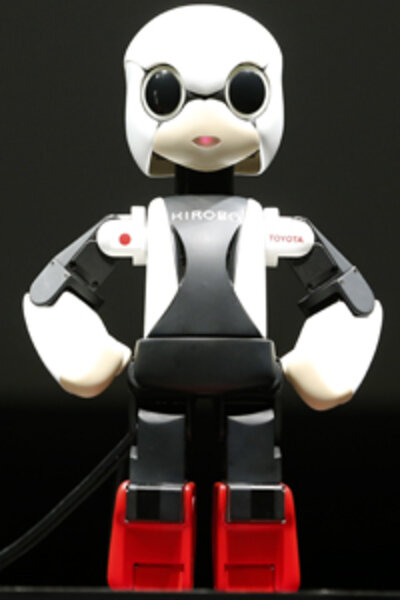Japan's one small step for robots, one giant leap for robot-kind
Loading...
| Tokyo
"I want to help create a world where humans and robots can live together," said the world’s first humanoid robot astronaut before it was launched into space from Japan on Sunday.
The robot, which can function in zero gravity, is being hailed as a leap forward in artificial intelligence because it can appear to express emotion during conversations. And at least it isn’t saying it dreams of a world dominated by robots – not while humans are listening, anyway.
The 13-inch, 2.2-pound “Kirobo” has been getting all the attention with its design modeled on the classic Astro Boy manga and anime character, and cute conversational skills. But the mission also signals both the continuing advancement and commercialization of Japan’s space program, and the development of further practical applications for robots back on terra firma.
Kirobo – its name a combination of kibo, the Japanese word for hope, and robot – lifted off from the Tanegashima Space Center, in the southern islands of the archipelago, onboard the Kounotori 4 cargo vessel, as part of a 3.5 ton payload of supplies and hardware carried by an H2B rocket and headed for the International Space Station.
Once Kirobo arrives at its destination, it will wait patiently until November, when Koichi Wakata arrives to take up his position as the first Japanese to captain the International Space Station (ISS).
It is programmed to recognize Mr. Wakata’s face and converse with him in Japanese, recording and relaying their chats back to a twin robot on earth as part of a study into using artificial intelligence to provide emotional comfort for people isolated for extended periods.
The robotics for Kirobo were developed by the University of Tokyo, the speech recognition system by Toyota, and the conversational content by advertising giant Dentsu.
Sunday’s launch saw Mitsubishi Heavy Industries take over from Japan’s space agency JAXA as project leader, with a view to Japan becoming a major player in the sector globally, taking payloads on a commercial basis from countries in Asia and the Middle East. It is slated to begin developing the next generation H3 rocket next year in partnership with the government.
“Japan has experienced failure in the past, but after each such failure we have gone through a very rigorous process to analyze what went wrong in design and process, and learn from it,” says Yuichi Tsuda, a scientist from the space flight research division at JAXA. “This is now a mature technology and it’s a very Japanese characteristic to be able to repeat processes very systematically,” says Dr. Tsuda.
With 25 launches under its belt, Japan’s space program can boast a success rate of 96 percent, putting it ahead of its European and Russian counterparts. The punctuality of the liftoffs is also a testament to Japanese perfectionism: Sunday’s launch was recorded as being 0.3 seconds late. Back on planet Earth, robots with advanced conversational skills and movement capabilities such as Kirobo are expected to play a growing role in caring for Japan’s burgeoning elderly population, an increasing number of who now live alone.
Robotic suits that older people can wear to compensate for declining physical prowess are also being tested in Japan, along with robots that can perform household chores independently.
Humanoids that can provide emotional comfort to go along with physical support, however, represent a new frontier in robotics. The Kounotori 4 carrying Kirobo is scheduled to arrive at the ISS on the morning of Aug. 9.







